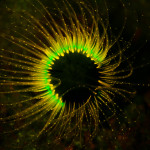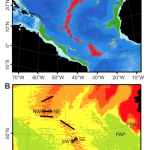

You can thank the major ocean spreading centers for the fact we all still don’t dwell on a Pangea Motherland. At nearly 10,000 kilometers in length and running approximately down the center of the North and South Atlantic Ocean the Mid-Atlantic Ridge (MAR) is the longest mountain chain and spreading center on Earth. Here, at this divergent tectonic plate boundary the Eurasian and North American Plates, and the African and South American Plates are separated. This separation increases by nearly 2cm per year. Most of the MAR is kilometers underwater with a few notable exceptions. This depth prevented its discovery until 1872 during the famous HMS Challenger expedition by some now dead crusty white guys.
A portion of the MAR, the Reykjanes Ridge, occurs above sea level in Iceland. Indeed, the countries volcanic activity and access to geothermal energy stems from the geological activity related to MAR. In the Thingvellir Valley of Iceland is located Silfra, a rift valley of the MAR. Fifty kilometers north of Silfra, Iceland’s second largest glacier “Lángjökull” melts (probably a little faster thanks to all of us). This water moves underground through a great distance of porous lava, which in turn filters the water. Water within Silfra is amazingly clear and visibility can easily be 100’s of meters. As you might expect, the geological novelty of the location and the clear water attract scuba divers.
As I found myself in Iceland for the Deep-Sea Biology Symposium, I felt compelled to dive Silfra*, aka “Diving the Crack”. First, let me go on record and say this ranks as one of my most amazing dives. It also ranks as my coldest with a water temperature around a balmy 35 degrees F. The site is every bit amazing and the water every bit as clear as legend holds. At one point in the dive, I actually simultaneously touched with my heavily gloved hands the North American and Eurasian Plates. A Youtube video of the Silfra experience is below the fold. Unfortunately Chariots of Fire did not play during my dive.

Of course all this Icelandic coolness doesn’t overshadow that this cheeky little island presents a formidable barrier for deep-sea animals. As you no doubt know if you regularly read DSN, the MAR is lined with hydrothermal vents (including the vent with my favorite name, Lucky Strike), areas where extremely hot, mineral-rich water spews from the seafloor. As larvae, vent species disperse with currents that run up and down the rift valley of the MAR until they hit a roadblock like freakin’ Iceland. Who put this landmass in the way? This means that populations of vent species North and South of Iceland on the MAR are genetically distinct. We often think of oceans as isolating island animals from their mainland relatives and ultimately leading to novel evolutionary trajectories promoting speciation. But those same islands also represent isolating barriers for the organisms of the deep.







jealous!
Excited that you were able to make this dive and witness this first-hand.